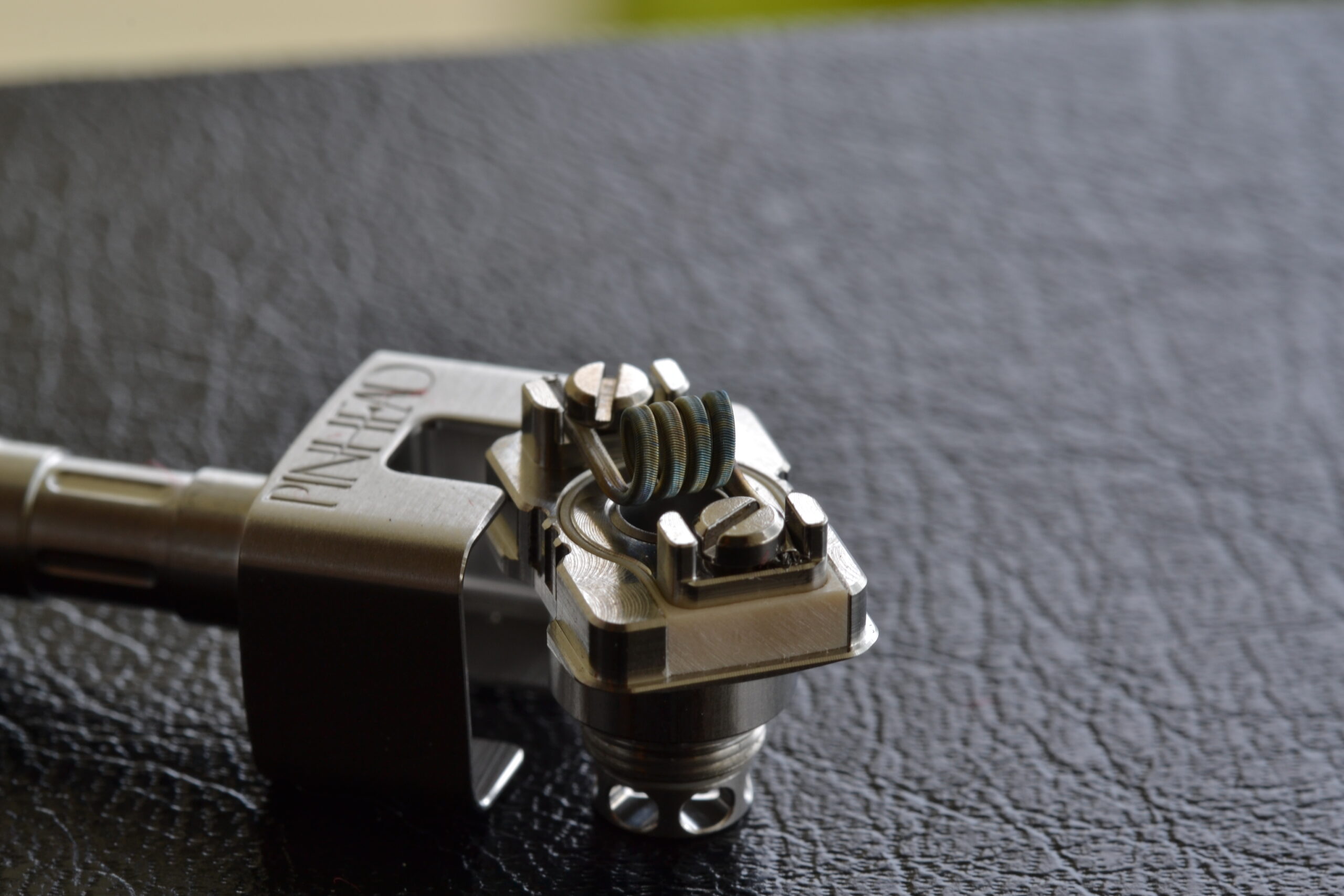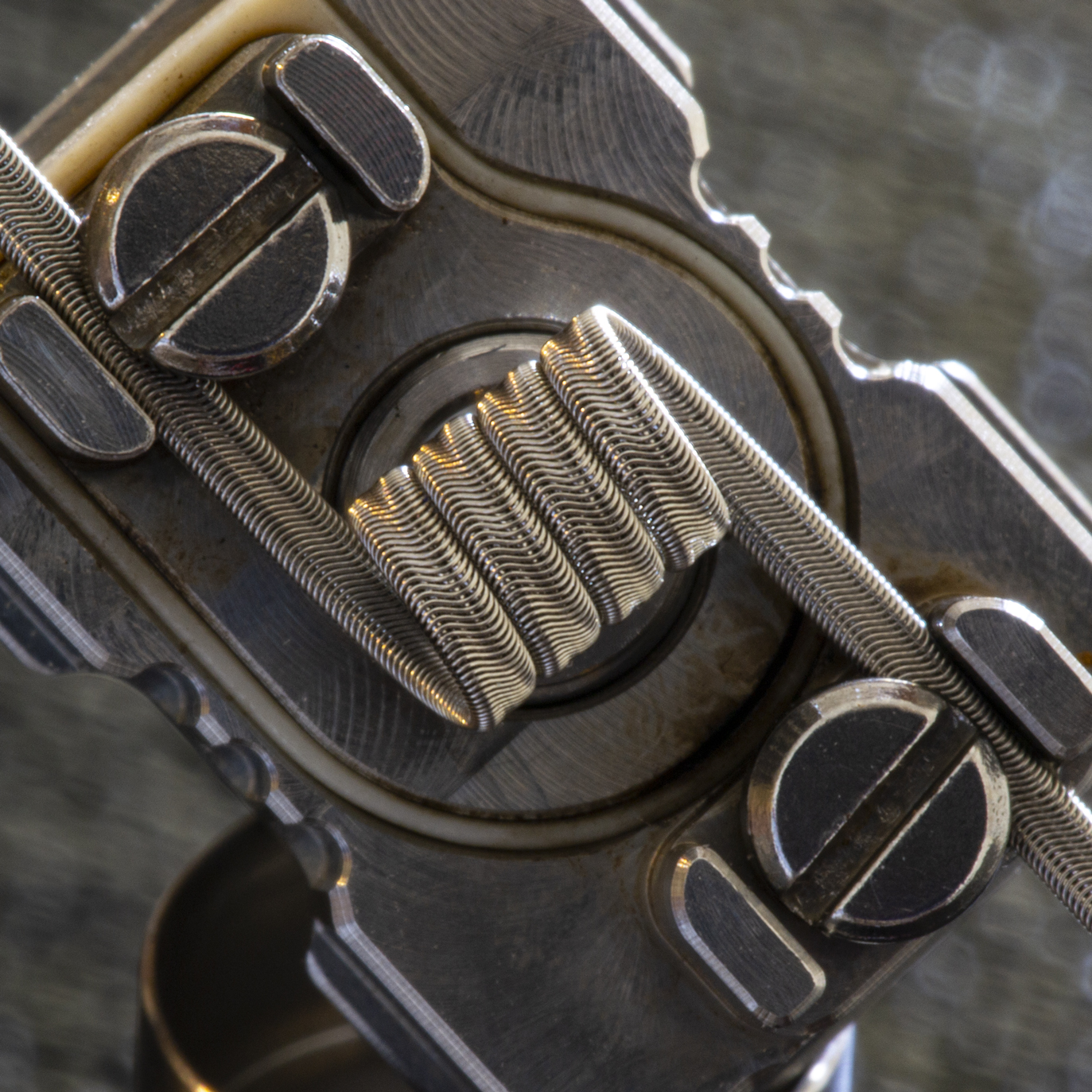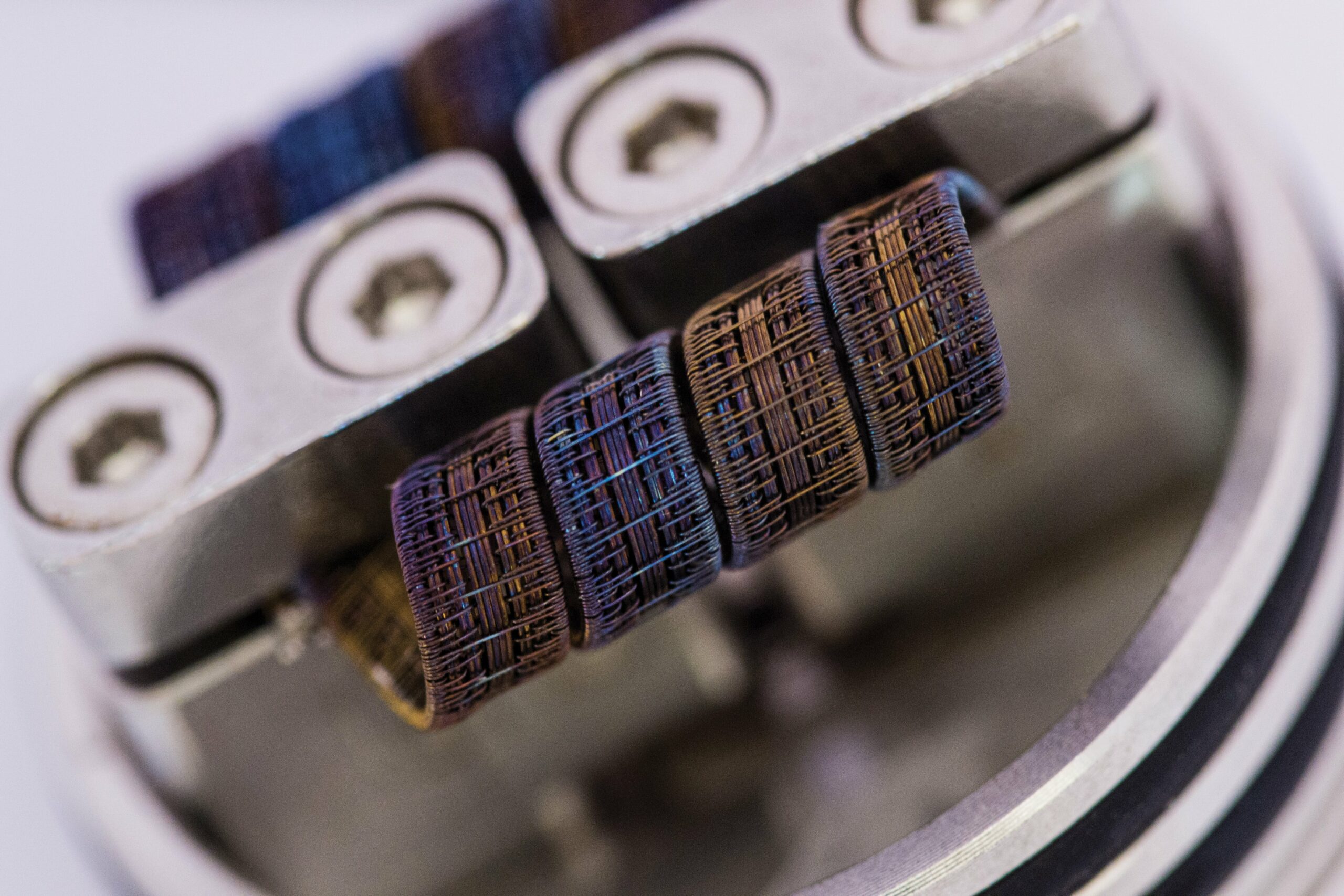INTRODUCTION: IN SEARCH OF FLAVOR
In this column, we will have the pleasure of delving into some aspects that determine the aromatic performance of coils, whether they are single-wire or complex. We’ll analyze the technical, chemical, and physical aspects while minimizing elements linked to suggestions and impressions. Our focus will be on everything that is parametric, effectively measurable, and verifiable.
By trying to identify what makes a coil—be it in a coil-head atomizer or a rebuildable—more performant, we can pinpoint three qualities:
- Vapor Production: How much vapor a coil produces.
- Aromatic Intensity and Hit: Closely linked and directly dependent on vapor production.
- Aromatic Definition: The ability to identify and separate all aromatic notes.
I don’t believe it’s necessary to delve into what vapor production or hit mean. Instead, it’s essential to explore the concept of flavor or aromaticity more deeply, and it’s worth addressing this topic from the root.
The perception of taste and scent of certain substances is determined by the interaction of specific chemical compounds with our receptors, such as taste buds but especially olfactory cells. Indeed, the senses of taste and smell are closely connected.
We can immediately notice a significant detail: on one hand, we have a parametric science dealing with the construction of aromas, but on the other, there’s a variable and highly personal biological system. The phrase “everyone has their own tastes” isn’t just a saying related to personal preferences; biologically, each person develops a certain sensitivity to different notes, and this sensitivity isn’t general but specific to each particular compound.
We’ve seen “what” perceives tastes and smells, but not “who” is the source—or rather, we’ve generically mentioned “molecules.” The molecules responsible for odors and flavors are of various types: properly called aromatic compounds (e.g., vanillin), terpenes (like pinene and limonene), phenols and alcohols (typically linked to floral aromas), aldehydes (cinnamon), ketones, esters, and so on. There’s an entire science dedicated to the construction and reconstruction of perfumes and aromas called aromatics or perfumery.
In this science, fragrances are referred to in terms of “notes,” relating to the aromatic impression that develops, specifically top, heart, and base notes:
- Top Notes are the first perceived. Typically linked to light and volatile molecules that evaporate quickly, they provide the immediate impact of a fragrance and often contribute to its sense of “freshness.” They are the “edges” of our “shape.” Examples include herbal, citrus, and floral notes.
- Once the top notes have evaporated or degraded, the core of the fragrance arrives—the Heart Notes. Linked to molecules more complex and lasting than the top notes, they determine the main character and personality of a fragrance, acting as a bridge between the top and base notes. Typically, these are spicy or fruity notes.
- Finally, we reach the Base Notes, the final phase of an aroma. Usually rich and heavy molecules with low volatility, they evaporate slowly. Base notes provide depth and warmth, anchoring the entire composition. Typically, these are woody or spicy notes, including vanilla.
HEAT, REACTIVITY, AND AROMATIC SEPARATION
Why does all this interest us, and how does it impact what happens in our atomizers? In our atomizers, we heat our flavored liquid at a relatively controlled temperature: heat influences the expression of different aromatic notes and the overall outcome of the experience.
Heat increases the evaporation rate of aromatic molecules, thereby increasing vapor production. However, excessive heat or heat reached too quickly can cause some delicate top notes to dissipate too rapidly, altering the balance. Similarly, heart notes prefer moderate heat to express maximum complexity. Base notes are more resistant and suitable for higher temperatures.
We’ve reached the crux of the matter: we have the tools to understand what to seek from a “perfect” coil—the maximum applicable power, with the utmost respect for all notes.
It becomes evident that if a coil is too reactive and reaches excessively high temperatures too quickly, it inhibits the expression of top notes and some heart notes, transforming a complex liquid into a shapeless, overly sweet mass. Conversely, a coil that’s too cool might not sufficiently express the base notes. The ideal strategy is a gradual ramp-up that reaches a consistent temperature.
We’ve understood that ramp-up is crucial for preserving all the notes. We’ve “equalized” our aromatic Hi-Fi in the best possible way; now we want… volume!
Increasing vapor production is probably the first parameter sought after, a source of great satisfaction. The first thing a new vaper asks is: how do I produce more vapor?
To achieve this, it might seem easy to think that simply increasing the power would suffice. But if we just increase the power, we’d only raise the heat. We also need to increase the evaporation surface. Achieving a larger surface while maintaining the thermal balance necessary to express all the aromatic notes requires that this surface has sufficient area to handle the supplied power. So… it’s time to leave chemistry and delve briefly into the physics of coils!
BASICS OF THERMODYNAMICS: JOULE EFFECT AND HEAT FLUX
From the first day we started vaping, we were taught Ohm’s law, crucial for understanding the relationship between current intensity, volts, and ohms. While it’s essential, on its own it’s quite useless in determining the efficiency and effectiveness of a coil. Imagine a 1-ohm coil for vaping at 14 watts; everything seems fine, right? But if it’s made with 20 wraps on a 3 mm rod using 20-gauge Kanthal A1 wire… it will never work! Why?
Because the mass is too high for the power expressed and required by our system!
We’re about to delve into the rabbit hole, and if what I’ve said so far seems obvious, you’ll realize how often this concept isn’t applied.
To fully understand the problem, we need to use another tool: Joule’s Law and the Joule Effect:
Q=I2×R×tQ = I^2 \times R \times tQ=I2×R×t
Where:
- QQQ represents the heat produced, measured in joules (J).
- III represents the current flowing through the conductor, measured in amperes (A).
- RRR represents the resistance of the conductor, measured in ohms (Ω).
- ttt represents the duration for which the current flows, measured in seconds (s).
This equation calculates the heat generated (in joules) when an electric current (in amperes) flows through a conductor with a certain resistance (in ohms) for a specific duration (in seconds).
You’ll notice that mass doesn’t appear in this equation, but it’s necessary to understand what happens if, for the same amount of heat—that is, the same joules produced—this heat is applied to a larger or smaller mass.
This relationship is determined by heat flux, which is the formula relating the produced heat to the surface over which it’s applied. Mathematically, heat flux is defined with the letter qqq, measured in watts per square meter:
q=QA×tq = \frac{Q}{A \times t}q=A×tQ
- QQQ is the amount of heat transferred, measured in joules (J).
- AAA is the surface area through which the heat transfer occurs, measured in square meters.
- ttt is the duration during which the heat transfer occurs, measured in seconds (s).
It’s generally accepted that a good heat flux ranges between 150 and 300 mW/mm², but naturally, this is subjective and doesn’t consider other crucial factors: the amount of air entering the system to moderate the temperature and the temperature moderation by the liquid.
For now, we’re interested in finding the relationship between the coil’s surface area and the applied power. I’ll spare you the simple mathematical steps; by combining Joule’s Law, Ohm’s Law, and heat flux, we get:
q=PAq = \frac{P}{A}q=AP
Looking at this formula again, we notice something interesting: for the amount of heat, the ohms (in a regulated system) aren’t relevant to the system’s thermodynamics! What matters instead is the surface area and the applied power! Obviously, if we venture into the world of mechanical mods, we need to consider the ohm value to achieve the desired power, but this doesn’t change the core issue. If a coil we have isn’t energetic and reactive enough for our tastes, or it has too much surface area, regardless of its ohm value, we need to reduce the mass or apply more power.
In summary, an ideal coil should be reactive yet gradual, reaching the ideal temperature for all the notes of the aromatic bouquet. Now we know that achieving this requires a precise balance between surface area and applied power.
The formula we’ve obtained allows us to understand that to increase vapor production while respecting all the notes, we need to increase the surface area while maintaining a balance with the wattage. We don’t necessarily need a coil with a lower ohm value but one with a larger surface area! Of course, the two things are connected, and factors like battery stress and their lifespan come into play, but today isn’t the day we’ll tackle that.
THE IMPACT OF COMPLEX COILS ON AROMATIC YIELD
We’ve reached the end of our feast; it’s time for dessert.
At some point in the evolution of the rebuildable world, once we entered cloud chasing, we sought to achieve increasingly larger surface areas. Thus, flat wires were born. However, while they increased the surface in terms of width, in absolute terms—let’s say mass—it was challenging to achieve balance because the coils were too wide and too fast.
We then started making parallel coils, which, by exploiting parallel resistance, achieved a superior balance between surface area and applied power. We began twisting wires together—first two, then three—and discovered something very interesting: twisting the wire significantly improved performance. Why?
Here, our friend capillarity comes into play. By twisting the wires together, we created channels that distributed the liquid not only on one side of the coil but also inside and along the entire path, constantly moderating the temperature. Experiments continued, led by a well-known figure, blueeyedgoon85, creator of the first true complex coils: Clapton, Fused Clapton, Alien, Staggered, and so on.
What happens in these coils? Capillarity is created inside the coil, whose role and ability to preserve and express the entire aromatic bouquet we discussed earlier are essentially linked to this capacity to constantly moderate the temperature and increase the evaporation surface. This expansion goes from the initial two dimensions of the single central channel of the single-wire coil to the three dimensions of all the internal micro-channels created by complex wraps and cores.
At this point, another factor changes the game completely—the presence of a wrap, which, while not altering the resistance, adds mass. The balance between surface area and wattage must be recalculated.
What does this mean? It means that depending on the type of wrap and its size, we’ll achieve different levels of capillarity and surface area.
The balance between the thickness of the wrap and the cores is crucial. The thinner the wrap, the easier it is to create high-performing coils that reach the ideal temperature without needing excessive power.
Also, the total number of wraps becomes important. They must be sufficient to balance the firing speed with the applied power, and if using a mechanical mod, also with the ohm value necessary to achieve the desired wattage.
Before delving into the world of custom coils and concluding this deep dive, I’d like to quickly analyze why mesh coils work so well in coil heads but perform poorly in “rebuildable” atomizers.
The intent to exploit the capillarity of mesh clashes with an objectively minimal surface area, which heats up incredibly fast, making it unsuitable for high power but extraordinarily efficient at lower power levels. However, aromatic intensity, aromatic separation, and hit aren’t increased because, to do so, we need to increase the power accompanied by maximum surface area and airflow.
Here, complex coils come into play—a completely different strategy to achieve maximum aromatic efficiency (rather than energy efficiency).
Let’s briefly analyze, point by point, summarizing in a few words: What changes between a Clapton, a Fused, an Alien, and a Staggered coil? Mainly the amount of wrap used and the number of internal channels:
- Clapton Single: Adds only external capillarity and little additional mass. A few more watts can be applied.
- Fused Clapton: Adds an internal channel, further moderating the temperature. The thicker the wrap, the greater the energy needed to properly activate the coil.
- Alien Coil: Further increases external capillarity by about 1/3 compared to a Fused Clapton of the same core.
- Staggered Coil: Complicates things even more, as the type of wrap adds a lot of capillarity but also more mass. For this reason, staggered coils tend to perform best when substantial power is applied to compensate and balance the mass and fully exploit the capillarity.
Thanks to what we’ve explored earlier and identified what determines a coil’s aromatic yield, it becomes incredibly easy to judge a coil, no matter how complex it may be. But there’s one last, counterintuitive factor:
It might seem that the greater the volume of empty spaces where capillarity occurs, the better the performance. However, capillarity has a prerogative: it performs best when traversing narrower spaces.
In fact, a Fused Clapton with two cores has a larger “empty” volume than a Stapled coil of the same size (composed internally of ribbon wire), yet its aromatic yield is significantly lower. Why?
For two reasons:
- The evaporation surface doesn’t coincide with the volume of internal channels—in fact, capillarity distributed over very small spaces is always more efficient and provides a greater evaporation surface.
- If capillarity has to occur over channels that are too wide, it’s not fast enough to supply liquid to the coil’s surface. This means the coil temporarily reaches higher temperatures, resulting in explosive and intermittent evaporation. Typically, this manifests as a characteristic crackling sound—nothing more than air trapped inside the channels during the fractions of a second when it’s not moderated by the liquid. As it heats up, it bursts out of the wrap, creating a depression that draws in more liquid, and so on. This leads to a type of vaporization that greatly emphasizes the base notes but often fails to preserve the top notes, consistently maintaining a high surface temperature.
That’s all for today. It has been a long but hopefully interesting journey into this fantastic world!






